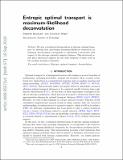| dc.contributor.author | Rigollet, Philippe | |
| dc.contributor.author | Weed, Jonathan | |
| dc.date.accessioned | 2020-08-20T00:59:20Z | |
| dc.date.available | 2020-08-20T00:59:20Z | |
| dc.date.issued | 2018-11 | |
| dc.identifier.issn | 1631-073X | |
| dc.identifier.uri | https://hdl.handle.net/1721.1/126692 | |
| dc.description.abstract | We give a statistical interpretation of entropic optimal transport by showing that performing maximum-likelihood estimation for Gaussian deconvolution corresponds to calculating a projection with respect to the entropic optimal transport distance. This structural result gives theoretical support for the wide adoption of these tools in the machine learning community. | en_US |
| dc.language.iso | en | |
| dc.publisher | Elsevier BV | en_US |
| dc.relation.isversionof | http://dx.doi.org/10.1016/j.crma.2018.10.010 | en_US |
| dc.rights | Creative Commons Attribution-NonCommercial-NoDerivs License | en_US |
| dc.rights.uri | http://creativecommons.org/licenses/by-nc-nd/4.0/ | en_US |
| dc.source | arXiv | en_US |
| dc.title | Entropic optimal transport is maximum-likelihood deconvolution | en_US |
| dc.type | Article | en_US |
| dc.identifier.citation | Rigollet, Philippe and Jonathan Weed. "Entropic optimal transport is maximum-likelihood deconvolution." Comptes Rendus Mathematique 356, 11-12 (November 2018): 1228-1235 © 2018 Académie des sciences | en_US |
| dc.contributor.department | Massachusetts Institute of Technology. Department of Mathematics | en_US |
| dc.relation.journal | Comptes Rendus Mathematique | en_US |
| dc.eprint.version | Original manuscript | en_US |
| dc.type.uri | http://purl.org/eprint/type/JournalArticle | en_US |
| eprint.status | http://purl.org/eprint/status/NonPeerReviewed | en_US |
| dc.date.updated | 2019-11-19T17:33:20Z | |
| dspace.date.submission | 2019-11-19T17:33:22Z | |
| mit.journal.volume | 356 | en_US |
| mit.journal.issue | 11-12 | en_US |
| mit.metadata.status | Complete | |
